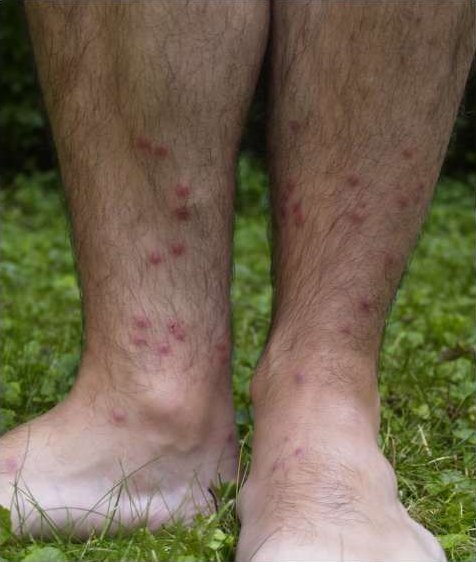Swimmer's Itch
Cercarial dermatitis, or swimmer’s itch, is a brief medical condition which humans have when they come in contact with a schistosomal parasite in fresh or brackish waters. The adult parasite infects some birds such as ducks, geese, gulls, swans, and mammals like raccoons and muskrats. The parasite lays eggs inside these birds or mammals, and the eggs pass in the feces of the host.
Subsequently, the eggs may land in water and hatch there. The result is the release of free-swimming microscopic larvae. Then the larvae search for a certain species of snail where they can grow and mature into adults after the snail acquires the infection. Once the snail has the infection, it releases the microscopic larvae, or cercariae, into the water (Centers for Disease Control).

source
To continue their life cycle, the cercariae look for a suitable host such as a bird or muskrat. Otherwise, the microscopic larvae will not survive for more than a day. The snails with the infection, however, will continue to produce cercariae for the rest of its life.
Humans are not suitable hosts for the microscopic larvae as the cercariae cannot develop and survive there. Some larvae will nevertheless burrow into the skin of humans who swim in those waters, and the cercariae will die within a day beneath the person’s epidermis. Humans, therefore, are accidental or dead-end hosts for the microscopic larvae.
After the cercariae die in the human, they release a protein which generates an allergic reaction in the person. This accounts for the brief medical condition which doctors call swimmer’s itch or cercarial dermatitis. It is a short illness which requires very little medical attention, and it resolves within a week or two.
Many patients can successfully manage swimmer’s itch without a visit to a physician, but the health care provider can prescribe a variety of remedies which will make the person comfortable. These include topical steroid creams, cool compresses to the affected area, Epsom salts or baking soda baths, or lotion to relieve itching.
Baking soda can also be useful as a topical preparation. One can mix baking soda with a small amount of water sufficient to make a paste and apply this to the area of the skin where the allergic reaction has taken place.
There has also been benefit from colloidal oatmeal baths.
It is not necessary to use all of these remedies as one or two of them will yield much improvement. There have not been any clinical research trials to examine and compare the various approaches to manage this rather benign medical condition which tends to occur during the summer months.
Sources
- Centers for Disease Control. Parasites—Cercarial dermatitis (also known as swimmer’s itch).
- World Health Organization. Schistosomiasis. (Bilharziasis).
I was confused at some point because the schistosomes I know about causes terrible conditions in humans. You may want to read a related article here.
Now I know there is a different type that adversely affects other animals than humans. I'd be glad if you could say what species this is.
Thanks for the insightful post.